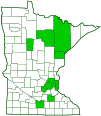Shaggy Parasol
(Chlorophyllum rhacodes)
Conservation • Description • Habitat • Ecology • Distribution • Taxonomy
Conservation Status |
|
|||||||
| IUCN Red List | not listed |
|||||||
| NatureServe | not listed |
|||||||
| Minnesota | not listed |
|||||||
Description |
||
Shaggy Parasol is the common name shared by two closely related mushrooms, Chlorophyllum rhacodes and Chlorophyllum brunneum. Both occur in North America, Europe, and southern Africa, only C. brunneum occurs in Australia. C. rhacodes occurs throughout North America but is more common east of the Rocky Mountains. C. brunneum is common in western United States but uncommon to rare in the east and absent from the Midwest. Only C. rhacodes has been recorded in Minnesota. It is widespread but not common in the state. Shaggy Parasol grows on the ground, usually in fairy rings or in groups, sometimes alone or scattered. It is found under trees and shrubs, especially conifers; in lawns, gardens, and compost piles; and on roadsides and other disturbed areas. It gets its nutrients from non-living organic material (saprobic). Shaggy Parasol is a large and conspicuous mushroom. The cap is smooth, brownish, and oval to almost round when young. As it grows the cap expands, becoming convex or marshmallow-shaped, and the universal veil breaks into small scales that adhere to the cap. The mature cap is 2″ to 8″ (5 to 20 cm) in diameter and flat, sometimes with a slightly raised bump in the middle (umbonate). The center remains brown and smooth or cracked, and the rest of the cap has scattered brown scales. This is the feature that gives the mushroom its common name. The upper surface is whitish and is covered with hair-like fibers (fibrillose). On older caps the margins turn up, cup-like, exposing the gills. The stalk is 2⅜″ to 8¼″ (6 to 21 cm) long, ⅝″ to 1⅜″ (1.5 to 3.5 cm) thick, and smooth, not shaggy. It gradually swells into a bulb at the base. It is white when young but stains brownish with age. Toward the top of the stalk there is a large membranous ring. It is all that remains of the partial veil. The ring is flat and thick with ragged double edges. It is collar-like, not skirt-like. This feature distinguishes Parasol mushrooms from poisonous Amanitas. On older mushrooms the ring is usually movable. It can slide up and down the stalk. The gills are broad, white, and closely spaced. They are free, not attached to the stalk. On older mushrooms they become pale brown and the edges turn brown. Between the main gills there is frequently another shorter gill. The cap, stalk, and gills stain brown when bruised or handled. The flesh is thick, whitish to pale brownish, and firm. When cut, it stains yellowish-orange or orange at first, soon turning reddish, and eventually turning brown. This discoloration is especially apparent if the flesh is cut near the top of the stalk. The flesh is edible when cooked but it has a high water content and should be fried uncovered. Some people have an allergic reaction and experience gastrointestinal pain and diarrhea from eating it. Others may pick the poisonous Green-spored Parasol (Chlorophyllum molybdites) or a deadly Amanita, mistaking it for this species. For these reasons, at least one source says it is “one of the most frequent causes of mushroom poisoning in the Pacific Northwest.” The spore print is white. |
||
Similar Species |
||
Habitat and Hosts |
||
Under trees, especially conifers, and shrubs, in lawns, gardens, and compost piles, and on roadsides and other disturbed areas |
||
Ecology |
||
Season |
||
Spring through fall |
||
Distribution |
||||
|
Sources |
|||
| 10/11/2021 | ||||
Occurrence |
||||
Widespread but not common in Minnesota |
||||
Taxonomy |
|||
| Kingdom | Fungi (Fungi) | ||
| Subkingdom | Dikarya | ||
| Phylum | Basidiomycota (Basidiomycete Fungi) | ||
| Subphylum | Agaricomycotina (Higher Basidiomycetes) | ||
| Class | Agaricomycetes (Mushrooms, Bracket Fungi, Puffballs, and Allies) | ||
| Subclass | Agaricomycetidae | ||
| Order | Agaricales (Common Gilled Mushrooms and Allies) | ||
| Suborder | Agaricineae | ||
| Family | Agaricaceae (field mushrooms and allies) | ||
Genus |
Chlorophyllum | ||
| Section | Rhacodium | ||
Synonyms |
|||
Agaricus rhacodes Lepiota rhacodes Lepiotophyllum rachodes Lepiotophyllum rhacodes Leucocoprinus rhacodes Macrolepiota rachodes Macrolepiota rhacodes Mastocephalus rhacodes |
|||
Common Names |
|||
Shaggy Parasol |
|||
Glossary
Fibrillose
On mushrooms, covered with fine hair-like fibers.
Partial veil
A protective covering over the gills or pores of a developing mushroom. At maturity it disappears, collapses into a ring around the stalk, or wears away into a cobwebby covering and ring zone.
Saprobic
A term often used for saprotrophic fungi. Referring to fungi that obtain their nutrients from decayed organic matter.
Umbonate
On mushrooms, having a distinct, raised, knob-like projection in the center of the cap.
Universal veil
An egg-like structure that envelopes all or most of a developing gill mushroom. Remnants of the universal veil sometimes visible on a mature mushroom are patchy warts on the cap, a ring on the stalk, and a volva at the base of the stalk.
What’s in a Name?
The species epithet is taken from the Greek rhakos, meaning “piece of cloth.” The correct spelling should be “rhacodes”. When the species was first described by Vittadini in 1835, the author misspelled it as “rachodes”, and this became the official name for the species. Some taxonomists “correct” the spelling, and this is allowed in Article 60.1 of the International Code of Nomenclature for algae, fungi, and plants.
Visitor Photos |
|||||
Share your photo of this fungus. |
|||||
| This button not working for you? Simply email us at info@MinnesotaSeasons.com. Attach one or more photos and, if you like, a caption. |
|||||
Mark Navarro |
|||||
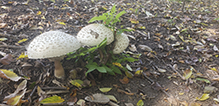 |
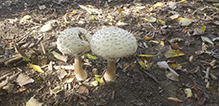 |
||||
Amy Gustafson |
|||||
Gorgeous Fungi on par with and resembling Lotus Flowers, Cream colored with brown freckles |
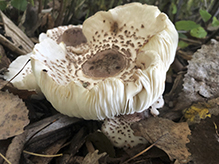 |
||||
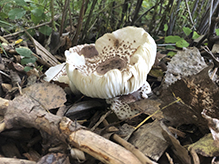 |
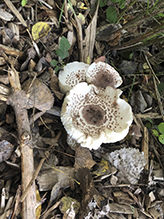 |
||||
MinnesotaSeasons.com Photos |
|||||
|
|||||

Slideshows |
||

Visitor Videos |
|||
Share your video of this fungus. |
|||
| This button not working for you? Simply email us at info@MinnesotaSeasons.com. Attach a video, a YouTube link, or a cloud storage link. |
|||
Other Videos |
|||
| Chlorophyllum rhacodes Cyanescentinel |
|||
About
Sep 18, 2010 Chlorophyllum rhacodes found between Kellogg and Shorecrest. Note the red juice being exuded on some of the caps. These were some large specimens, as big as my outstretched hand. |
|||
| shaggy parasol (Chlorophyllum rhacodes or rachodes) Mike the cave man |
|||
About
Sep 16, 2020 an edible but tricky to identify species also it is toxic raw it needs to be cooked we are not eating these but they came up in our yard I thought they were a shaggy mane when they first popped up I looked it up and found that it can be mistaken for many including the green spored parasol mushroom the parasol mushroom as brown marking on the stalk and turn pink flesh inserted of this red orange color I have lepiota brunneoincarnata is in my front yard I believe it it is a little old we did a comparison in this video |
|||
| Shaggy Parasol Mushroom - Identify and Forage Mushroom Wonderland |
|||
About
Jul 30, 2021 This is a video of how to Identify the "Shaggy Parasol" mushroom, AKA Chlorophyllum Rhacodes, C. Olivieri. A delicious saprobic mushroom, meaning that it grows on decaying matter rather than mycorrhizal fungi that need certain trees to grow. This mushroom can be found in the Pacific Northwest growing in deciduous forests, meadows, horse pastures, on the borders of woodlands, in tall grass, well...pretty much anywhere. They usually grow in large abundant patches and can easily be identified by the moveable ring on the stipe, the shaggy top, and the reddish staining and bruising. A somewhat fragile, large, and delicious edible mushroom that you should learn to forage and bring home to your dinner table. |
|||
| Wild Fungi-Shaggy Parasol Reconnect2 Nature |
|||
About
Oct 1, 2020 Chlorophyllum (formerly Macrolepiota) rhacodes, the Shaggy Parasol, is a fairly common mushroom found mainly in or beside woods and hedges. It is smaller than the Parasol Mushroom, Macrolepiota procera, and its stem lacks the snakeskin-like patterning associated with the Parasol. The generic name Chlorophyllum means 'with green gills' and is a reference to the green-gilled poisonous mushroom Chlorophyllum molybdites, which is common in North America. Other species in this genus have white or pale cream spores, as indeed does Chlorophyllum rhacodes. Carlo Vittadini erroneously transcribed the Greek word rhakos, meaning rag - a piece of cloth (this mushroom does often look rather ragged!), to the Latinised form rachos, resulting in the specific epitet rachodes rather than rhacodes. Some reference texts that you may come across may therefore use the scientific name Chlorophyllum rachodes for this species. (Another synonym for this species is Lepiota rhacodes.) If you would like to support what I do, please consider the donation link below. Thank you so much in advanced, and much love! paypal.me/ReconnectTwoNature |
|||
| Shaggy Parasols : May 2018 (At 4k resolution). Diarmuid NZ |
|||
About
Jun 3, 2018 Foraging for Shaggy Parasol Mushrooms (Chlorophyllum rhacodes), then cooking and eating them. Recommendations: Before eating any new wild mushroom, please do ample research; ensure you have identified it correctly; ensure it is in prime condition; cook it thoroughly; only try a small piece at first to ensure no adverse health effects; only eat small amounts at a time and not too often. |
|||

Visitor Sightings |
|||||
Report a sighting of this fungus. |
|||||
| This button not working for you? Simply email us at info@MinnesotaSeasons.com. Be sure to include a location. |
|||||
| Amy Gustafson 9/22/2021 |
Location: Washington County MN, Oakdale Bark Park, 4957 Helena Rd N, Oakdale MN 55128 Gorgeous Fungi on par with and resembling Lotus Flowers, Cream colored with brown freckles |
|
|||
MinnesotaSeasons.com Sightings |
|||||
|
|||||

Created: 10/11/2021
Last Updated:
